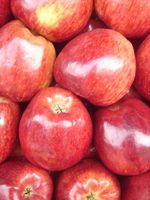Dig this list of British food waste headlines from last week:
50m [pound] Grants to deal with food waste
Fruit and vegetable waste clogs landfills.
Brits waste third of food.
Warning over “outrageous” WRAP budget cuts
Smart Planet provides a list of 10 ways you can rescue old fruit and vegetables.
Now take a look at research data from a Waste & Resources Action Program (WRAP) study, British households throw away 4.4 million whole apples every day.
A statistic like this had me wondering – did someone go through millions of British trash cans to get this number? I e-mailed an inquiry to WRAP’s press office representative, Susan Nisbet. Here is the interesting Q&A that followed:
NAC: I am currently working on covering your campaign’s food waste program, but I’m having trouble understanding how you came up with a figure like 4.4 million apples. How did you conduct your research?
WRAP: This information has been obtained through a recently completed study funded by WRAP to estimate in detail the nature, scale and origin of food waste. The research was designed not only to quantify the amounts and types of food waste being produced in the UK but also to make explicit links between the amounts and types of waste a household disposes of, and the attitudes, socio-demographics and disposal options available to that household. The study consisted of two linked elements – a survey and a physical analysis of the contents of bins (done with householders consent). More than 2,100 households took part in the research (11 Local Authorities in England and Wales), forming a representative sample of the UK and enabling data for the whole of the UK to be accurately estimated.
During the food analysis stage, the researchers extracted any items of food from the collected waste. The food was then identified, categorized and details recorded (e.g. whole/ intact vs. part-consumed; raw vs. cooked, etc). In addition, food items were categorized in to:
Avoidable food waste. The food has been thrown away because it is no longer wanted or has been allowed to go past its best. Examples include an apple or half a pack of cheese.
Possibly avoidable food waste. This is food waste that could possibly have been avoided but incorporates food items that can be eaten but which many choose not to. Examples include bread crusts and potato skins.
Unavoidable food waste. This waste arises from food preparation and includes foods such as meat bones and hard vegetable or fruit peelings (e.g. melon rind) This analysis revealed that, when scaled up to a UK level, ca 4.4 million untouched apples are thrown away each year in the UK, weighing ca 179,000t.
NAC: If you say the research hasn’t been completed and will be published in May, how do you have a figure like this?
WRAP: WRAP have highlighted the fact that fruit and vegetables make up a very significant part of the food thrown away in the UK since launch. As with any WRAP funded project we will aim to disseminate the key findings as soon as practicable, and publish full reports at the end of the project. Obtaining and disseminating top line data on fruit and vegetables, and examples such as the top 5 most wasted whole fruit and vegetables, was prioritized for reasons given above (40 percent etc). The full report will be available and widely disseminated in May 2008.
So… are you as confused as I am? It’s an interesting study and it seems that WRAP has compiled a lot of data. Maybe I’m missing something here, but does this figure represent apples specifically, or a combination of different food wastes adding up to the weight of 4.4 million apples? And what is a “UK Level?” Is there a British apple measuring system that’s different than ours? Let’s just say my time was worn out with WRAP and I’m going to have to wait until May.
But I’m impatient… do any of you know anything about British apples and food waste? Let the comments fly!








